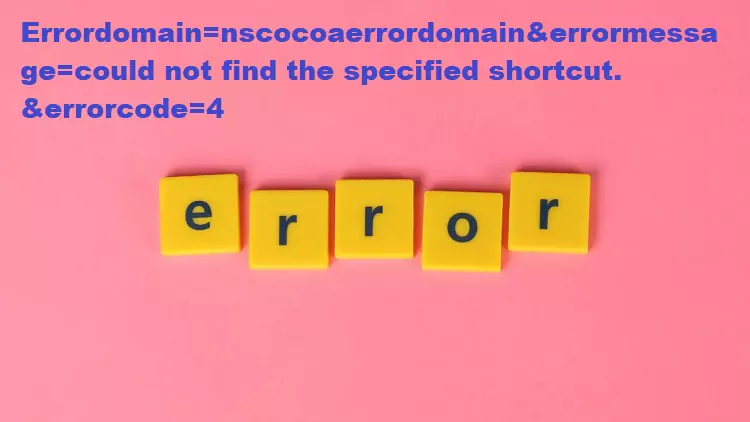Errors can be frustrating, especially when they prevent you from performing essential tasks on your computer. One such error that users might encounter is “Errordomain=nscocoaerrordomain&errormessage=could not find the specified shortcut.&errorcode=4”. This error message indicates a problem related to the NSCocoaErrorDomain, a domain used by Apple’s Cocoa framework for handling errors in macOS and iOS applications.
Understanding the NSCocoaErrorDomain
The NSCocoaErrorDomain is an error domain in Apple’s Cocoa framework. It encompasses a wide range of errors that can occur when working with macOS and iOS applications. The framework categorizes errors into different domains to provide a structured approach to error handling and resolution.
In the context of the NSCocoaErrorDomain, errors can occur due to various reasons such as file I/O, property list serialization, or general application-specific issues. By identifying the error domain, developers and users can gain insights into the underlying cause of the error.
Error Message: “Could not find the specified shortcut.”
The error message “could not find the specified shortcut” is a specific error message associated with the NSCocoaErrorDomain. This error message suggests that the application or system was unable to locate a specific shortcut that was expected to be present.
To resolve this error, it’s important to investigate the possible causes that could lead to this issue. Let’s explore some potential reasons behind this error:
- Insufficient permissions or access rights: The user account or application may lack the necessary permissions to access or modify the shortcut.
- Missing or corrupted files: The shortcut file may be missing or corrupted, preventing the system from locating it.
- Incompatibility issues: Changes in the operating system or software updates can sometimes render shortcuts incompatible, causing them to be inaccessible.
To troubleshoot this error, we can follow a step-by-step approach.
Troubleshooting Steps
Step 1: Verify the specified shortcut exists
Check if the specified shortcut is present in the designated location. Ensure that the shortcut’s path is accurate and hasn’t been changed or moved unintentionally.
Step 2: Check permissions and access rights
Review the permissions and access rights for the shortcut file. Ensure that the user account or application has sufficient privileges to access and modify the shortcut.
Step 3: Ensure the required files are present and not corrupted
Confirm that all the files required by the shortcut are present and intact. If any files are missing or corrupted, try to restore them from a backup or reinstall the necessary software.
Step 4: Update or reinstall relevant software
If the error persists, consider updating or reinstalling the software associated with the shortcut. Newer versions or fresh installations can resolve compatibility issues and provide a more stable environment for the shortcuts to function correctly.
Step 5: Contact support or seek further assistance
If the error remains unresolved, it is advisable to reach out to the software’s support team or seek assistance from technical forums or communities. They can provide specific guidance tailored to your situation and help troubleshoot the error in more detail.
By following these troubleshooting steps, you can increase the chances of resolving the “Errordomain=nscocoaerrordomain&errormessage=could not find the specified shortcut.&errorcode=4” error effectively.
Best Practices to Avoid the Error
To minimize the occurrence of NSCocoaErrorDomain errors or similar issues in the future, consider adopting the following best practices:
- Keep your software and operating system up to date to benefit from bug fixes and improvements.
- Maintain proper file management and organization, ensuring shortcuts are correctly linked and easily accessible.
- Adhere to recommended coding practices and guidelines when developing applications to reduce the likelihood of errors.
- Regularly back up important files and configurations to safeguard against data loss or corruption.
Implementing these best practices can help prevent potential errors and ensure a smoother user experience when working with macOS and iOS applications.
Conclusion
The “Errordomain=nscocoaerrordomain&errormessage=could not find the specified shortcut.&errorcode=4” error is a specific error message related to the NSCocoaErrorDomain. Understanding the error domain, message, and associated error code is crucial for effective troubleshooting and resolution.
By following the provided troubleshooting steps and adopting best practices, you can mitigate the occurrence of this error and improve the overall stability and performance of your applications.
Remember, if you encounter difficulties or the error persists, don’t hesitate to seek support from relevant channels. Troubleshooting and resolving errors promptly can enhance your productivity and user experience.

Mark Thompson, a seasoned pest controller, is renowned for his expertise in keeping homes and businesses free from unwanted intruders. With a passion for environmental sustainability and a deep understanding of pest behavior, Mark has become a trusted authority in the industry.
